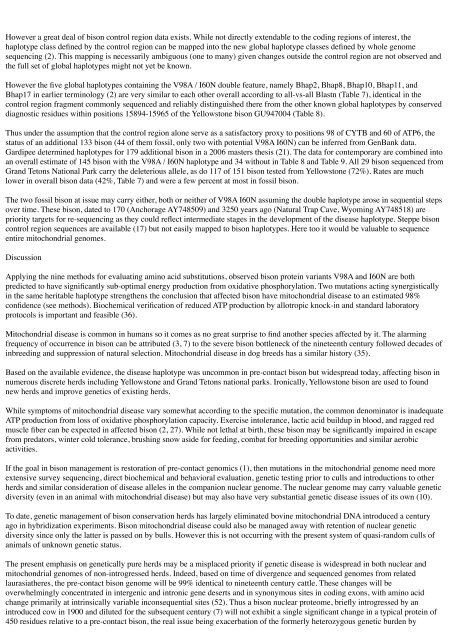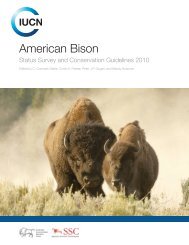Declaration Dr. Thomas H. Pringle - Buffalo Field Campaign
Declaration Dr. Thomas H. Pringle - Buffalo Field Campaign
Declaration Dr. Thomas H. Pringle - Buffalo Field Campaign
Create successful ePaper yourself
Turn your PDF publications into a flip-book with our unique Google optimized e-Paper software.
However a great deal of bison control region data exists. While not directly extendable to the coding regions of interest, the<br />
haplotype class defined by the control region can be mapped into the new global haplotype classes defined by whole genome<br />
sequencing (2). This mapping is necessarily ambiguous (one to many) given changes outside the control region are not observed and<br />
the full set of global haplotypes might not yet be known.<br />
However the five global haplotypes containing the V98A / I60N double feature, namely Bhap2, Bhap8, Bhap10, Bhap11, and<br />
Bhap17 in earlier terminology (2) are very similar to each other overall according to all-vs-all Blastn (Table 7), identical in the<br />
control region fragment commonly sequenced and reliably distinguished there from the other known global haplotypes by conserved<br />
diagnostic residues within positions 15894-15965 of the Yellowstone bison GU947004 (Table 8).<br />
Thus under the assumption that the control region alone serve as a satisfactory proxy to positions 98 of CYTB and 60 of ATP6, the<br />
status of an additional 133 bison (44 of them fossil, only two with potential V98A I60N) can be inferred from GenBank data.<br />
Gardipee determined haplotypes for 179 additional bison in a 2006 masters thesis (21). The data for contemporary are combined into<br />
an overall estimate of 145 bison with the V98A / I60N haplotype and 34 without in Table 8 and Table 9. All 29 bison sequenced from<br />
Grand Tetons National Park carry the deleterious allele, as do 117 of 151 bison tested from Yellowstone (72%). Rates are much<br />
lower in overall bison data (42%, Table 7) and were a few percent at most in fossil bison.<br />
The two fossil bison at issue may carry either, both or neither of V98A I60N assuming the double haplotype arose in sequential steps<br />
over time. These bison, dated to 170 (Anchorage AY748509) and 3250 years ago (Natural Trap Cave, Wyoming AY748518) are<br />
priority targets for re-sequencing as they could reflect intermediate stages in the development of the disease haplotype. Steppe bison<br />
control region sequences are available (17) but not easily mapped to bison haplotypes. Here too it would be valuable to sequence<br />
entire mitochondrial genomes.<br />
Discussion<br />
Applying the nine methods for evaluating amino acid substitutions, observed bison protein variants V98A and I60N are both<br />
predicted to have significantly sub-optimal energy production from oxidative phosphorylation. Two mutations acting synergistically<br />
in the same heritable haplotype strengthens the conclusion that affected bison have mitochondrial disease to an estimated 98%<br />
confidence (see methods). Biochemical verification of reduced ATP production by allotropic knock-in and standard laboratory<br />
protocols is important and feasible (36).<br />
Mitochondrial disease is common in humans so it comes as no great surprise to find another species affected by it. The alarming<br />
frequency of occurrence in bison can be attributed (3, 7) to the severe bison bottleneck of the nineteenth century followed decades of<br />
inbreeding and suppression of natural selection. Mitochondrial disease in dog breeds has a similar history (35).<br />
Based on the available evidence, the disease haplotype was uncommon in pre-contact bison but widespread today, affecting bison in<br />
numerous discrete herds including Yellowstone and Grand Tetons national parks. Ironically, Yellowstone bison are used to found<br />
new herds and improve genetics of existing herds.<br />
While symptoms of mitochondrial disease vary somewhat according to the specific mutation, the common denominator is inadequate<br />
ATP production from loss of oxidative phosphorylation capacity. Exercise intolerance, lactic acid buildup in blood, and ragged red<br />
muscle fiber can be expected in affected bison (2, 27). While not lethal at birth, these bison may be significantly impaired in escape<br />
from predators, winter cold tolerance, brushing snow aside for feeding, combat for breeding opportunities and similar aerobic<br />
activities.<br />
If the goal in bison management is restoration of pre-contact genomics (1), then mutations in the mitochondrial genome need more<br />
extensive survey sequencing, direct biochemical and behavioral evaluation, genetic testing prior to culls and introductions to other<br />
herds and similar consideration of disease alleles in the companion nuclear genome. The nuclear genome may carry valuable genetic<br />
diversity (even in an animal with mitochondrial disease) but may also have very substantial genetic disease issues of its own (10).<br />
To date, genetic management of bison conservation herds has largely eliminated bovine mitochondrial DNA introduced a century<br />
ago in hybridization experiments. Bison mitochondrial disease could also be managed away with retention of nuclear genetic<br />
diversity since only the latter is passed on by bulls. However this is not occurring with the present system of quasi-random culls of<br />
animals of unknown genetic status.<br />
The present emphasis on genetically pure herds may be a misplaced priority if genetic disease is widespread in both nuclear and<br />
mitochondrial genomes of non-introgressed herds. Indeed, based on time of divergence and sequenced genomes from related<br />
laurasiatheres, the pre-contact bison genome will be 99% identical to nineteenth century cattle. These changes will be<br />
overwhelmingly concentrated in intergenic and intronic gene deserts and in synonymous sites in coding exons, with amino acid<br />
change primarily at intrinsically variable inconsequential sites (52). Thus a bison nuclear proteome, briefly introgressed by an<br />
introduced cow in 1900 and diluted for the subsequent century (7) will not exhibit a single significant change in a typical protein of<br />
450 residues relative to a pre-contact bison, the real issue being exacerbation of the formerly heterozygous genetic burden by










